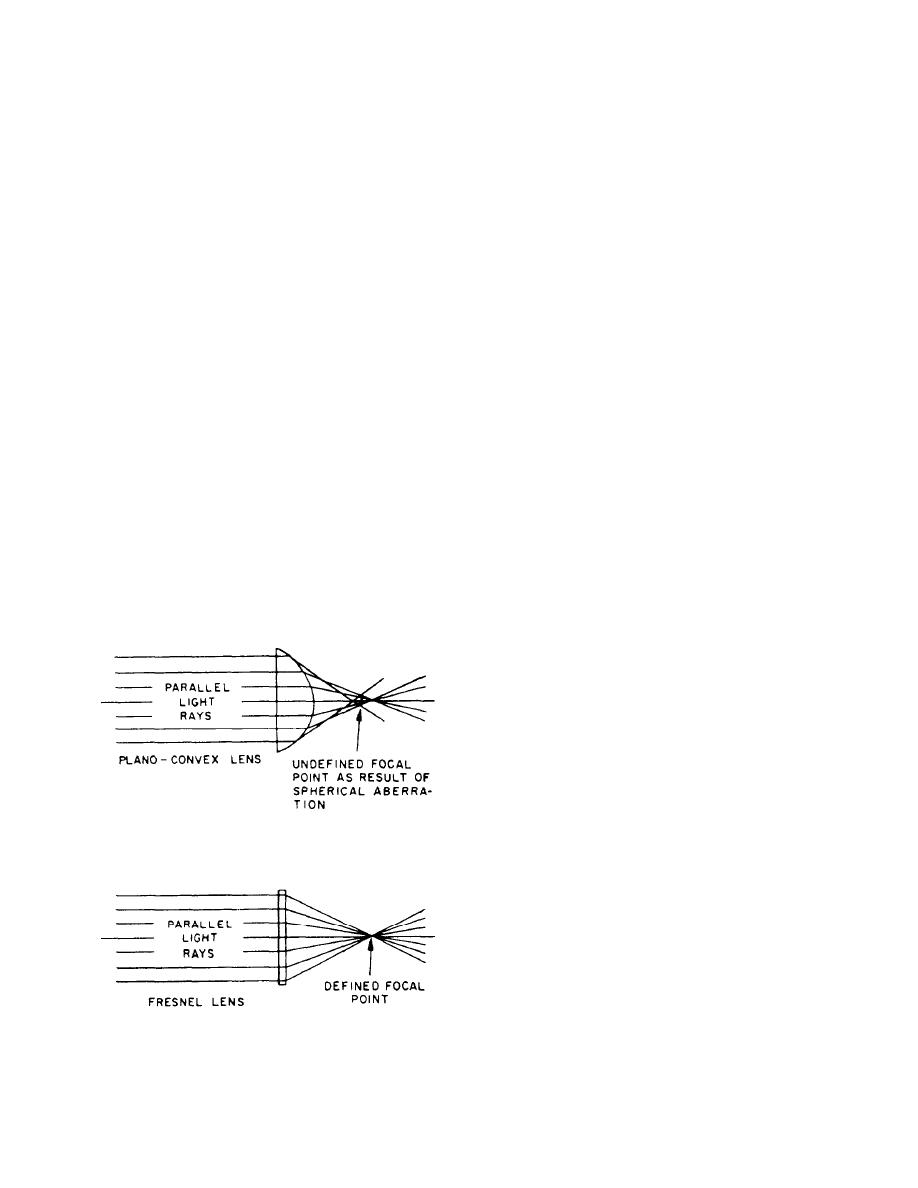 |
|||
|
Page Title:
Figure 3-11.--Comparison of optical characteristics of piano-convex lens and Fresnel lens. |
|
||
| ||||||||||
|
|
 The second effect that will be observed is that the
light rays, as illustrated in figure 3-11. When the rays of
motion of the bar of light from the cell center to the
light, parallel to the principal axis of a convex spherical
transition line does not appear to be smooth. At higher-
lens, pass through zones near the edge of the lens, the
than-design temperature, the bar of light disappears in
principal focus occurs at a point that is closer to the lens
the observed cell before it starts to appear in the adjacent
than the focus for rays that pass through the lens near
cell. At lower-than-design temperatures, the bar of light
the principal axis. Therefore, the light rays from a plano-
disappears into the transition line before a bar of light
convex spherical lens tend to scatter. The Fresnel lens
starts to appear in the adjacent cell. At extreme tem-
also can be formed around a suitable radius to minimize
peratures, it is possible to get blank areas or double bars
astigmatism. Astigmatism of a lens is the inability of the
of light at or near the transition line.
lens to bring all the light rays from a point on an object
to a sharp focus to form the image.
The last effect that will be observed is that the
vertical field angle (angle of the lens from top to bottom
The optical characteristics of the Fresnel lens will
as viewed from the front) is larger when the ambient
vary appreciably with a change in temperature. If the
temperature is higher than design temperature and
lens temperature is allowed to vary beyond operational
smaller when the ambient temperature is lower than the
limits, three effects will be observed. First, the size of
design temperature. To maintain design characteristics
the bar of light near the center of the lens is different
of the Fresnel lens, the lens-heating compartments are
from that which is seen near the center of the lens when
maintained at a temperature that is relatively constant.
the lens is at design temperature. Also, as the observer
The Fresnel lenses are each enclosed in a separate
moves up or down, the size of the bar of light appears
compartment in which a lenticular lens serves as the
to change as the image moves from the lens center to the
front and an optical glass serves as the back of the
transition line between cell assemblies. The transition
compartment. Hot air is circulated in the compartment
line is defined as the physical break between the cells.
under thermostatic control.
If the ambient temperature is higher than design tem-
perature, the bar of light at the center appears smaller
LENTICULAR LENS
than the design bar of light, and it blooms to a larger-
than-design bar of light at the transition line between
A lenticular lens is placed in front of each Fresnel
cells. If the ambient temperature is lower than design
lens. Each lenticular lens consists of many long, convex,
temperature, the opposite conditions occur.
cylindrical lenses placed side by side, as shown in
figure 3-12. Each individual lens has the same short
focal length. The area in which the light source (the
object) can be viewed is spread by the short focal length
of the lenticular lens. If the object consists of a multiple-
light source with spacing between the lights, the object
appears to an observer looking into the lens as a con-
tinuous band of light that fills the width of the lens. In
the GSI system, the arrangement of the lenses with
respect to the source lamps and the physical properties
of the lenses cause the source lamps to appear as a single
light image 12 inches wide and approximately 1/2 inch
high. The object appears as a continuous band of light
regardless of the observer's position in the azimuthal
range of the lenticular lens. The azimuthal range is the
angular position (expressed in degrees) in a horizontal
plane in which a pilot of an approaching aircraft can
observe the band of light. The azimuthal range of the
lenticular lens used in the Fresnel system is 40 (see
fig. 3-12). The appearance of the height of the object is
not affected by the lenticular lens.
The lenticular lens in the GSI assembly is manu-
Figure 3-11.--Comparison of optical characteristics of
factured with three different color segments to eliminate
piano-convex lens and Fresnel lens.
the need for filters and their subsequent light
3-8
|
|
Privacy Statement - Press Release - Copyright Information. - Contact Us |